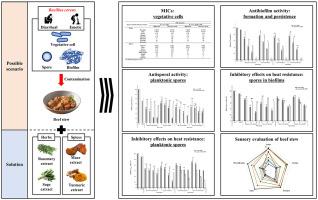Reduction of viability, heat resistance, and biofilm formation and persistence of Bacillus cereus spores in beef stew broth by herb and spice extracts
IF 8
1区 农林科学
Q1 FOOD SCIENCE & TECHNOLOGY
引用次数: 0
Abstract
This study investigated the inhibitory effects of ethanol extracts from 16 plants (8 herbs and 8 spices) on the viability, heat resistance, biofilm formation, and persistence of two different toxigenic Bacillus cereus spores in beef stew broth. Two B. cereus strains, namely, B. cereus CH3 (diarrheal type) and B. cereus JCM 17690 (emetic type), were tested. Based on the lowest minimum inhibitory concentration (MIC) both in vitro and in situ, the most effective herbs and spices were selected: rosemary (0.3125 mg/mL; identical in both strains and tests) and sage (0.3125 mg/mL) among herbs; mace (0.625 mg/mL) and turmeric (0.625 mg/mL) among spices. In addition, all extracts prepared from powdered forms of herbs and spices consistently exhibited equal or lower MICs than those prepared from dried forms. Meanwhile, all four selected extracts prepared from powdered forms significantly reduced spore viability (reduction rate of herbs: 50.46–90.91 %; spices: 52.36–86.01 %) and heat resistance (reduction rate of herbs: 16.64–48.63 %; spices: 9.69–45.41 %). All the extracts also completely inhibited the biofilm formation of B. cereus spores and effectively disrupted the preformed biofilms (i.e., reduction of biofilm persistence; reduction rate of herbs: 12.16–77.83 %; spices: 14.13–70.99 %). In addition, they significantly reduced the heat resistance (reduction rate of herbs: 9.45–35.67 %; spices: 8.90–28.27 %) of spores in biofilm. Such inhibitory effects of the extracts were shown in a concentration-dependent manner, and the intensity of inhibition appeared to be strain specific. These findings indicate that the application of natural plant extracts, in combination with conventional heat treatment, may provide a promising strategy for controlling B. cereus contamination in beef stew and other ready-to-eat meat products.

草药和香料提取物对牛肉炖汤中蜡样芽孢杆菌孢子活力、耐热性、生物膜形成和持久性的影响
本文研究了16种植物(8种草药和8种香料)乙醇提取物对牛肉炖肉汤中两种不同产毒蜡样芽孢杆菌孢子活力、耐热性、生物膜形成和持久性的抑制作用。检测了2株蜡样芽孢杆菌,即蜡样芽孢杆菌CH3(腹泻型)和蜡样芽孢杆菌JCM 17690(呕吐型)。以体外和原位最低抑菌浓度(MIC)为标准,筛选出抑菌效果最好的中药和香料:迷迭香(0.3125 mg/mL,菌株和试验均相同)和鼠尾草(0.3125 mg/mL);肉豆蔻(0.625 mg/mL)和姜黄(0.625 mg/mL)。此外,所有从粉末形式的草药和香料中制备的提取物始终表现出与从干燥形式制备的提取物相同或更低的mic。同时,四种粉末提取物均显著降低了孢子活力(草本降低率:50.46 ~ 90.91%,香料降低率:52.36 ~ 86.01%)和耐热性(草本降低率:16.64 ~ 48.63%,香料降低率:9.69 ~ 45.41%)。各提取物均能完全抑制蜡样芽孢杆菌孢子生物膜的形成,有效破坏已形成的生物膜(即生物膜持久性降低,草本植物的降低率为12.16 ~ 77.83%,香料的降低率为14.13 ~ 70.99%)。此外,它们还显著降低了生物膜孢子的耐热性(降低率为草药9.45 ~ 35.67%,香料8.90 ~ 28.27%)。这些提取物的抑制作用呈浓度依赖性,抑制强度似乎是菌株特异性的。这些发现表明,应用天然植物提取物,结合传统热处理,可能为控制炖牛肉和其他即食肉制品中的蜡样芽孢杆菌污染提供一种有前途的策略。
本文章由计算机程序翻译,如有差异,请以英文原文为准。
求助全文
约1分钟内获得全文
求助全文
来源期刊

Food Research International
工程技术-食品科技
CiteScore
12.50
自引率
7.40%
发文量
1183
审稿时长
79 days
期刊介绍:
Food Research International serves as a rapid dissemination platform for significant and impactful research in food science, technology, engineering, and nutrition. The journal focuses on publishing novel, high-quality, and high-impact review papers, original research papers, and letters to the editors across various disciplines in the science and technology of food. Additionally, it follows a policy of publishing special issues on topical and emergent subjects in food research or related areas. Selected, peer-reviewed papers from scientific meetings, workshops, and conferences on the science, technology, and engineering of foods are also featured in special issues.
 求助内容:
求助内容: 应助结果提醒方式:
应助结果提醒方式:


